
The drum is a member of the percussion group of musical instruments. In the Hornbostel-Sachs classification system, it is a membranophone. Drums consist of at least one membrane, called a drumhead or drum skin, that is stretched over a shell and struck, either directly with the player's hands, or with a percussion mallet, to produce sound. There is usually a resonant head on the underside of the drum. Other techniques have been used to cause drums to make sound, such as the thumb roll. Drums are the world's oldest and most ubiquitous musical instruments, and the basic design has remained virtually unchanged for thousands of years.

As it is a country with many different tribes and ethnic groups, the music of Indonesia itself is also very diverse, coming in hundreds of different forms and styles. Every region has its own culture and art, and as a result traditional music from area to area also uniquely differs from one another. For example, each traditional music are often accompanied by their very own dance and theatre. Contemporary music scene have also been heavily shaped by various foreign influences, such as America, Britain, Japan, Korea, and India.
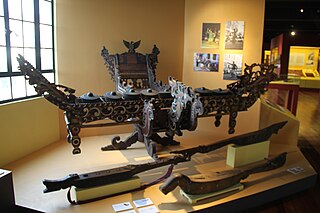
Kulintang is a modern term for an ancient instrumental form of music composed on a row of small, horizontally laid gongs that function melodically, accompanied by larger, suspended gongs and drums. As part of the larger gong-chime culture of Southeast Asia, kulintang music ensembles have been playing for many centuries in regions of the Southern Philippines, Eastern Malaysia, Eastern Indonesia, Brunei and Timor, Kulintang evolved from a simple native signaling tradition, and developed into its present form with the incorporation of knobbed gongs from Sundanese people in Java Island, Indonesia. Its importance stems from its association with the indigenous cultures that inhabited these islands prior to the influences of Hinduism, Buddhism, Islam, Christianity or the West, making kulintang the most developed tradition of Southeast Asian archaic gong-chime ensembles.

The suling is a musical instrument of the Sundanese people in Indonesia. It is used in the Degung ensemble. Bamboo ring flute can also be found in Southeast Asian, especially in Brunei, Indonesia, Malaysia, the Philippines and Singapore.

A slit drum or slit gong is a hollow percussion instrument. In spite of its often being called a drum, it is not a true drum but an idiophone, usually carved or constructed from bamboo or wood, in the form of a mostly closed hollow chamber with one or more slits in it. It is played by striking near the edge of the slit. In some designs, the slit is a single straight line; in others, the slit is used to create one or more "tongues", achieved by cutting three sides of a rectangular shape and leaving the fourth side attached. Most slit drums have one slit, though two and three slits occur. Tongues of different areas or thicknesses will produce different pitches. Slit drums are used throughout Africa, Southeast Asia, and Oceania. In Africa such drums, strategically situated for optimal acoustic transmission, have been used for long-distance communication.
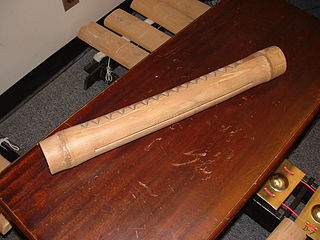
The kagul is a type of Philippine bamboo scraper gong/slit drum of the Maguindanaon and Visayans with a jagged edge on one side, played with two beaters, one scraping the jagged edge and the other one making a beat. The Maguindanaon and the Banuwaen use it in the rice paddies to guard against voracious birds, using the sound it produces to scare them away. The Maguindanaon and the Bukidnon also used to use it for simple dance rhythms during social occasions. The rhythms were usually simplistic in nature, consisting of one rhythmic pattern sometimes combined with another. Use of the kagul in the former way is no longer practiced.

The agung is a set of two wide-rimmed, vertically suspended gongs used by the Maguindanao, Maranao, Sama-Bajau and Tausug people of the Philippines as a supportive instrument in kulintang ensembles. The agung is also ubiquitous among other groups found in Palawan, Panay, Mindoro, Mindanao, Sabah, Sulawesi, Sarawak and Kalimantan as an integral part of the agung orchestra.
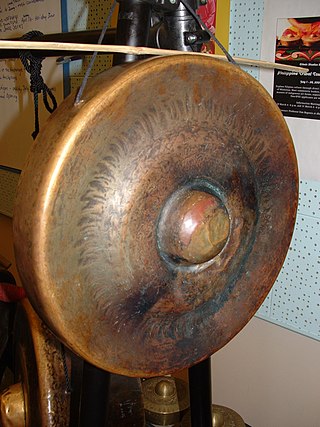
The babandil is a single, narrow-rimmed Philippine gong used primarily as the “timekeeper” of the Maguindanao kulintang ensemble.

The gandingan is a Philippine set of four large, hanging gongs used by the Maguindanao as part of their kulintang ensemble. When integrated into the ensemble, it functions as a secondary melodic instrument after the main melodic instrument, the kulintang. When played solo, the gandingan allows fellow Maguindanao to communicate with each other, allowing them to send messages or warnings via long distances. This ability to imitate tones of the Maguindanao language using this instrument has given the gandingan connotation: the “talking gongs.”
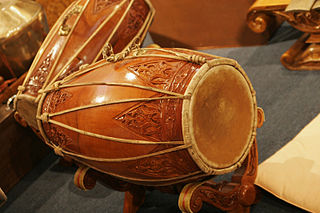
A kendang or gendang is a two-headed drum used by people from the Indonesian Archipelago. The kendang is one of the primary instruments used in the gamelan ensembles of Javanese, Sundanese, and Balinese music. It is also used in various Kulintang ensembles in Indonesia, Brunei, Malaysia, Singapore, and the Philippines. It is constructed in a variety of ways by different ethnic groups. It is related to the Indian double-headed mridangam drum.

The kubing is a type of Philippine jaw harp from bamboo found among the Maguindanaon and other Muslim and non-Muslim tribes in the Philippines and Indonesia. It is also called kobing (Maranao), kolibau (Tingguian), aru-ding (Tagbanwa), kuribaw, aribao (Isneg), aroding (Palawan), kulaing (Yakan), ulibaw (Kalinga), karombi (Toraja), yori (Kailinese) or Kulibaw. Ones made of sugar palm-leaf are called karinta (Munanese), ore-ore mbondu or ore Ngkale (Butonese).
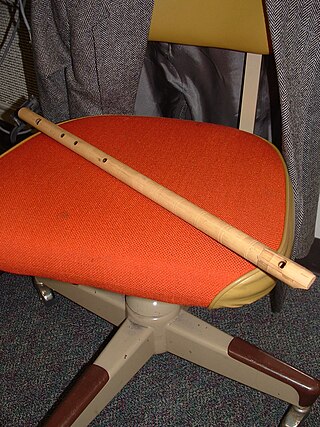
The tumpong is a type of Philippine bamboo flute used by the Maguindanaon, half the size of the largest bamboo flute, the palendag. A lip-valley flute like the palendag, the tumpong makes a sound when players blow through a bamboo reed placed on top of the instrument and the air stream produced is passed over an airhole atop the instrument. This masculine instrument is usually played during family gatherings in the evening and is the most common flute played by the Maguindanaon.
The kutiyapi, or kudyapi, is a Philippine two-stringed, fretted boat-lute. It is four to six feet long with nine frets made of hardened beeswax. The instrument is carved out of solid soft wood such as that from the jackfruit tree.

Singkil is a folk dance of the Philippines that has its origins in the Maranao people of Lake Lanao, a Mindanao Muslim ethnolinguistic group. The dance is widely recognized today as the royal dance of a prince and a princess weaving in and out of crisscrossed bamboo poles clapped in syncopated rhythm. While the man manipulates a sword and shield, the woman gracefully twirls a pair of fans. The dance takes its name from the belled accessory worn on the ankles of the Maranao princess. A kulintang and agung ensemble always accompanies the dance. Singkil has evolved over time, with significant reinterpretations and changes introduced by the Bayanihan folk dance group, such as the incorporation of the elements from the Darangen epic, particularly the episodes involving Prince Bantugan and Princess Gandingan.
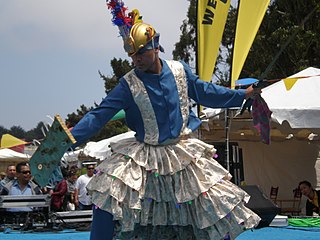
Sagayan is a Philippine war dance performed by Maguindanao, Maranao and Iranun depicting in dramatic fashion the steps their hero, Prince Bantugan, took upon wearing his armaments, the war he fought in and his subsequent victory afterwards. Performers, depicting fierce warriors would carry shields with shell noisemakers in one hand and double-bladed sword in the other attempting rolling movements to defend their master.
Traditional Thai musical instruments are the musical instruments used in the traditional and classical music of Thailand. They comprise a wide range of wind, string, and percussion instruments played by both the Thai majority as well as the nation's ethnic minorities.

Philippine traditional musical instruments are commonly grouped into four categories: aerophones, chordophones, membranophones, and idiophones.
The Maguindanao kulintang ensemble is a musical ensemble in the kulintang tradition of the Maranao and the Maguindanao. Other forms of the kulintang ensembles are played in parts of Southeast Asia especially in the eastern parts of Maritime Southeast Asia — the Southern Philippines, Eastern Indonesia, Eastern Malaysia, Brunei and Timor. There are mainly five instruments on the ensemble: Kulintang, Agung, Gandingan, Babendil and Dabakan.

Bamboo's natural hollow form makes it an obvious choice for many musical instruments. In South and South East Asia, traditional uses of bamboo the instrument include various types of woodwind instruments, such as flutes, and devices like xylophones and organs, which require resonating sections. In some traditional instruments bamboo is the primary material, while others combine bamboo with other materials such as wood and leather.

The tube zither is a stringed musical instrument in which a tube functions both as an instrument's neck and its soundbox. As the neck, it holds strings taut and allows them to vibrate. As a soundbox, it modifies the sound and transfers it to the open air. The instruments are among the oldest of chordophones, being "a very early stage" in the development of chordophones, and predate some of the oldest chordophones, such as the Chinese Se, zithers built on a tube split in half. Most tube zithers are made of bamboo, played today in Madagascar, India, Southeast Asia and Taiwan. Tube zithers made from other materials have been found in Europe and the United States, made from materials such as cornstalks and cactus.





















